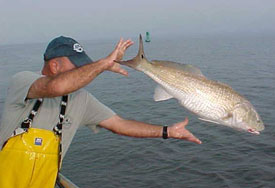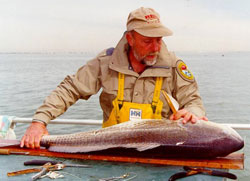Fisheries Research at MRRI
Adult Red Drum Research
 South Carolina Department of Natural Resources employees having been sampling the adult red drum population since 1994 using bottom longline gear with research primarily conducted at sites within the Charleston Harbor jetties and nearshore live bottom areas.
South Carolina Department of Natural Resources employees having been sampling the adult red drum population since 1994 using bottom longline gear with research primarily conducted at sites within the Charleston Harbor jetties and nearshore live bottom areas.
The goal of this project is to gather information on stock structure, migratory behavior, and escapement of sub-adults to the adult population in order to evaluate the effectiveness of stock enhancement and changes in fisheries regulations.
The sub-adult red drum becomes part of the adult population at an age of 3 to 5 years. The escapement of these sub-adults to the adult population allows the adult population to maintain a healthy age-structure; with many age classes represented in the population. The level of escapement can be manipulated by making changes in the fisheries regulations; the more restrictive the regulations, the more sub-adults that will be allowed to escape to spawning age. Once in the adult population the red drum is beyond the upper end of the size limit and should only be subjected to natural, and catch and release mortality. The red drum's maximum life span has been estimated to reach 40 to 50 years along the Southeastern coast. The adult population inhabits coastal to offshore waters, and exhibits an inshore to offshore migratory pattern moving offshore in the fall and winter and returning into the lower reaches of the bays and sounds in the spring and summer to spawn. The population of adult red drum is monitored by a tag and release biologists depend on both fishery dependent (anglers) and fishery independent data for this study. The reporting of tagged adult red drum is critical to this project. Anglers are asked to record:

- tag number
- date
- location
- length
- condition of the fish
and submit this information to:
Morgan Hart
Phone Number: 843-953-9410.
Anglers will be provided a reward for completed tag returns. Please do not cut or otherwise remove the tags from the fish. In addition to long term data collection that is reported to the Atlantic States Marine Fisheries Commission and the National Marine Fisheries Service for use in regional stock assessments, as study is being conducted to evaluate retention in two types of external tags.
